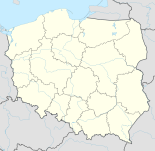Przerwanki
| Przerwanki | ||
|---|---|---|

|
|
|
| Basic data | ||
| State : | Poland | |
| Voivodeship : | Warmia-Masuria | |
| Powiat : | Węgorzewo | |
| Gmina : | Pozezdrze | |
| Geographic location : | 54 ° 8 ' N , 21 ° 55' E | |
| Height : | 123 m npm | |
| Residents : | ||
| Postal code : | 11-610 | |
| Telephone code : | (+48) 87 | |
| License plate : | NWE | |
| Economy and Transport | ||
| Street : | Kruklanki - Wiłudy ↔ Jakunówko - Grodzisko Banie Mazurskie / ext. 650 | |
| Rail route : | no rail connection | |
| Next international airport : | Danzig | |
Przerwanki ( German Przerwanken , 1907 to 1945 Wiesental ) is a place in the Polish Warmian-Masurian Voivodeship , which belongs to the rural municipality Pozezdrze (Possessern , 1938 to 1945 Großgarten) in the powiat Węgorzewski ( Angerburg district ).
Geographical location
Przerwanki is located on the northwest bank of the Jezioro Gołdopiwo ( German Goldapgar Lake ) in the northeast of the Warmian-Masurian Voivodeship. The river Sapina ( German Sapiene ) runs through the village . The district town of Węgorzewo ( German Angerburg ) is 15 kilometers to the northwest.
history
The Year of the time Spitzenort is referred village the year 1549. Subsequently, the place hisse Spitzing , Spitz rings (prior to 1627), Szerwancken (by 1774), Sperwancken (by 1777), Pszerwanken (according to 1785) and Przerwanken (up to 1907). The districts of Klein Eschenort ( Jasieńczyk in Polish ) and Wilkusmühle (Wilkus) belonged to the community until 1945 .
From 1874 to 1945 was Przerwanken - renamed "Wiesental" on October 15, 1907 - Office and village its name to an office district, which the district Angerburg in Administrative district Gumbinnen the Prussian province of East Prussia belonged.
378 residents were registered in Wiesental in 1910. Their number decreased to 346 by 1933 and was the same in 1939.
In 1945, the village came in consequence of the war with the entire southern East Prussia to Poland and received the Polish form of the name "Przerwanki". Assigned to him is the residential area (Polish przysiółek) Jasieńczyk (Klein Eschenort) , which at the same time and with the place Wilkus (Wilkusmühle) belongs to the Schulzenamt (Polish sołectwo) Przerwanki. As such, Pzerwanki is included in the association of the rural community Pozezdrze (Possessern , 1938 to 1945 Großgarten) in the powiat Węgorzewski ( Angerburg district ), before 1998 the Suwałki Voivodeship , since then part of the Warmia-Masurian Voivodeship .
District Przerwanken / Wiesental (1874–1945)
The Przerwanken District (from 1907 "Wiesental District") originally consisted of five, in the end of four villages:
| Surname | Change name | Polish name | Remarks |
|---|---|---|---|
| Painted beams | Gębałka | ||
| Small stalk | Stręgielek | ||
| Przerwanken , village |
1907–1945: Wiesental |
Przerwanki | |
| Przytullen , village |
1938–1945: small cowls |
Przytuły | |
| Przytuły, good | 1928 incorporated into the rural community of Przytullen |
On January 1, 1945, Gembalken, Kleinkutten, Klein Strengeln and Wiesental still formed the district.
Religions
Przerwanken was parish up to 1945 in the Protestant Church Kutten ( Polish Kuty ) in the church province of East Prussia of the Church of the Old Prussian Union and in the Catholic Church Zum Guten Hirten Angerburg (Polish Węgorzewo) in the Diocese of Warmia .
Today Przerwanki belongs to both the Catholic parish in Kuty in the diocese of Ełk (Lyck) of the Roman Catholic Church in Poland and to the Protestant parish of Węgorzewo, a branch of the parish in Giżycko (Lötzen) in the diocese of Masuria of the Evangelical-Augsburg Church in Poland .
Lock Przerwanki
In 1910 a lock was built near Wiesental. Restored in 1949, it enables small ships to sail on the Sapina from Jezioro Gołdopiwo to Jezioro Wilkus (Wilkussee) . The lock is 25 meters long and four meters wide.
traffic
Przerwanki is to the east of a side street, the Kruklanki (Kruglanken) via Jakunówko (Jakunowken , 1938 to 1945 Jakunen) and Grodzisko (Grodzisko , 1925 to 1938 Schloßberg , 1938 to 1945 Heidenberg) with the Polish voivodship street DW 650 (formerly German Reichsstraße 136 ) at Banie Mazurskie (Benkheim) connects.
Web links
Individual evidence
- ↑ Polish Postal Code Directory 2013, p. 1042
- ^ Dietrich Lange, Geographical Register of Places East Prussia (2005): Wiesental
- ↑ Pzrerwanken
- ↑ a b Rolf Jehke, Przerwanken / Wiesental district
- ^ Uli Schubert, community directory, district of Angerburg
- ↑ Michael Rademacher: German administrative history from the unification of the empire in 1871 to the reunification in 1990. The district of Angerburg (Polish Wegorzewo). (Online material for the dissertation, Osnabrück 2006).
- ↑ Walther Hubatsch : History of the Protestant Church in East Prussia. Volume 3: Documents. Göttingen 1968, p. 476


